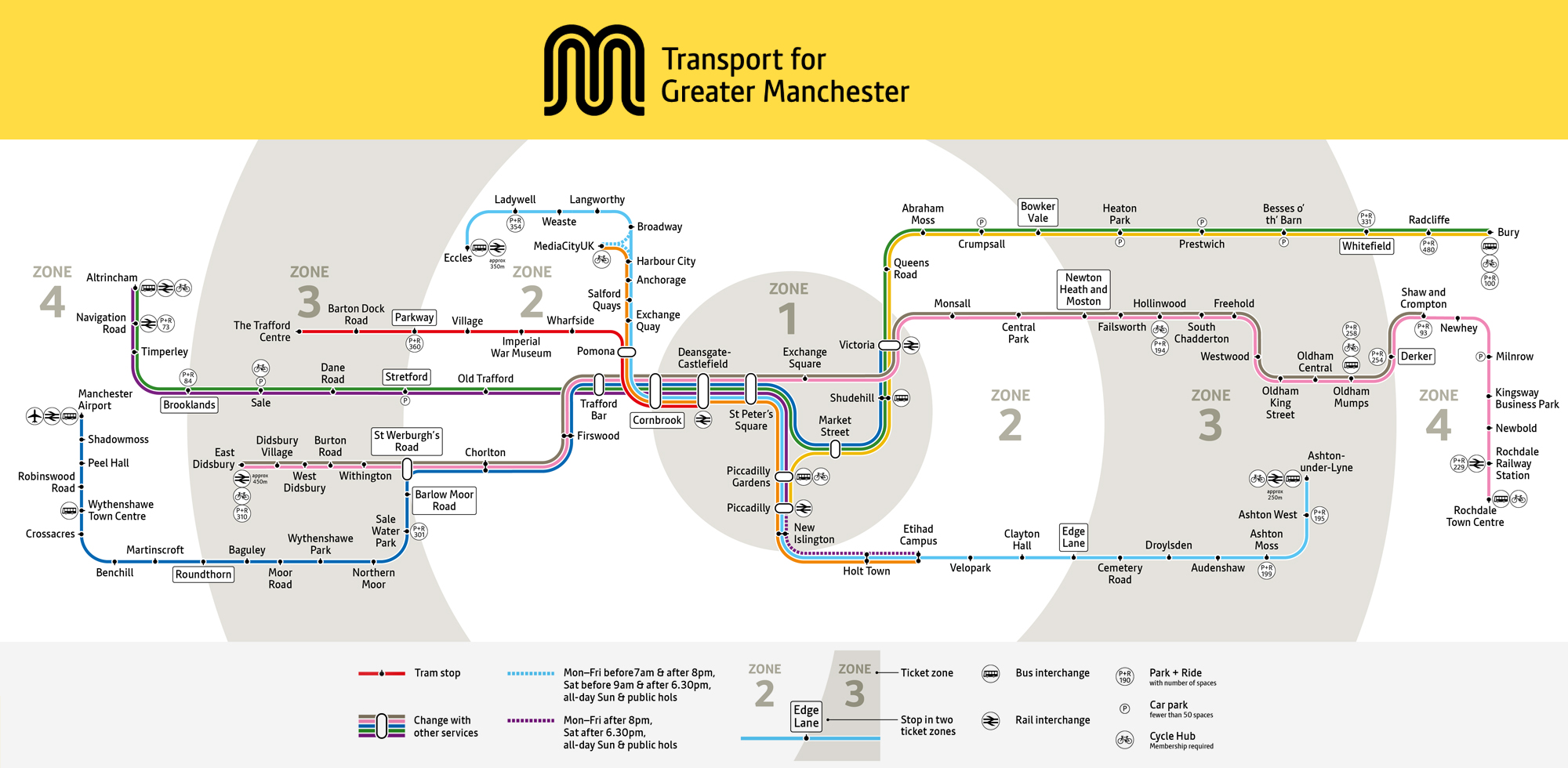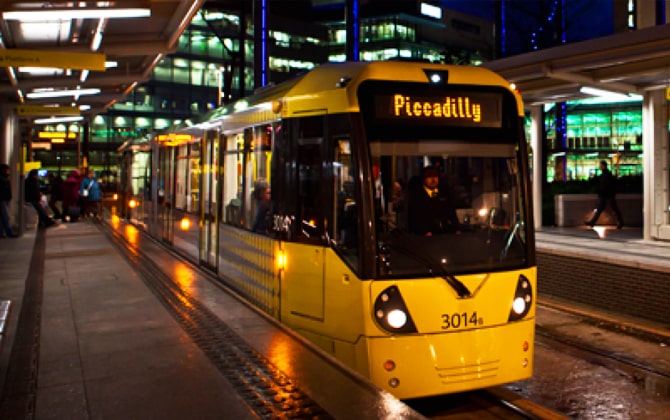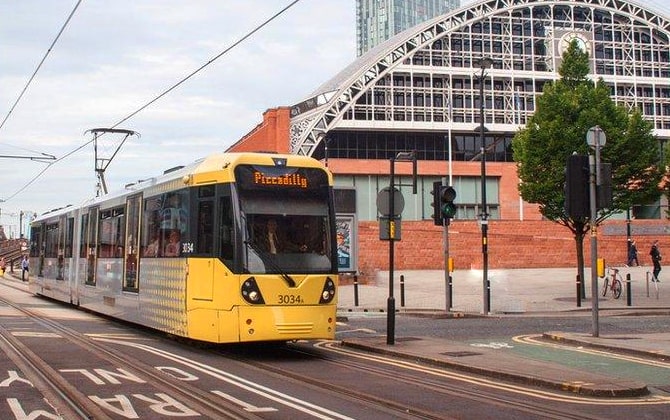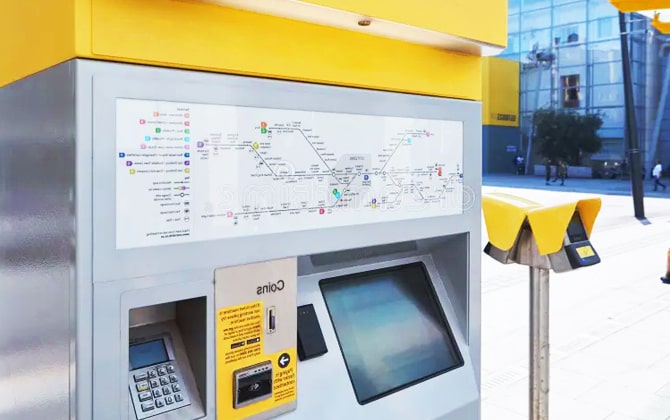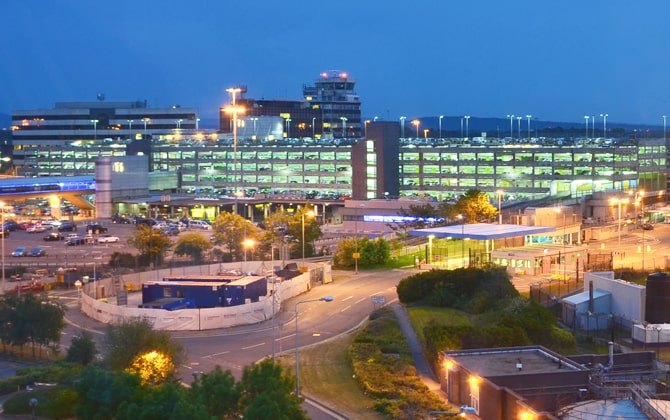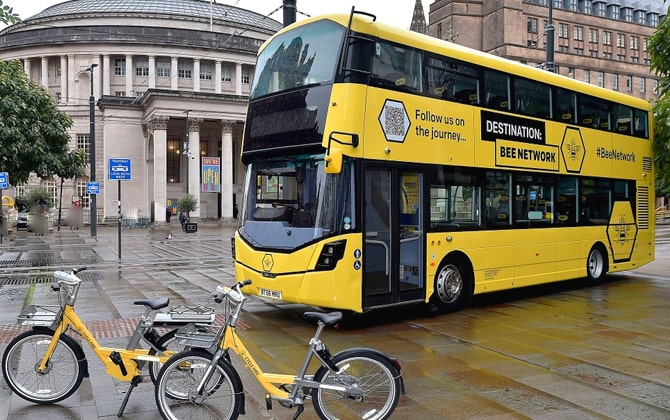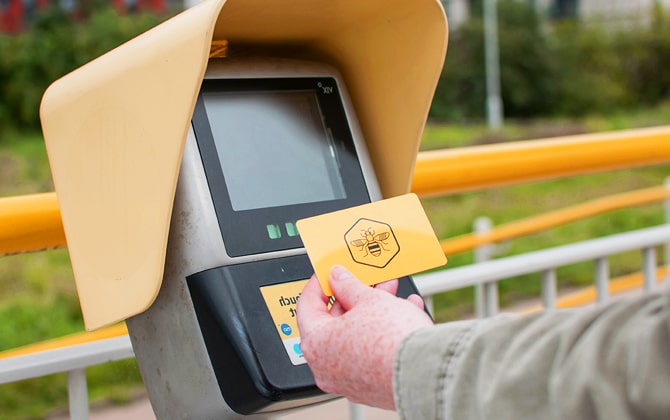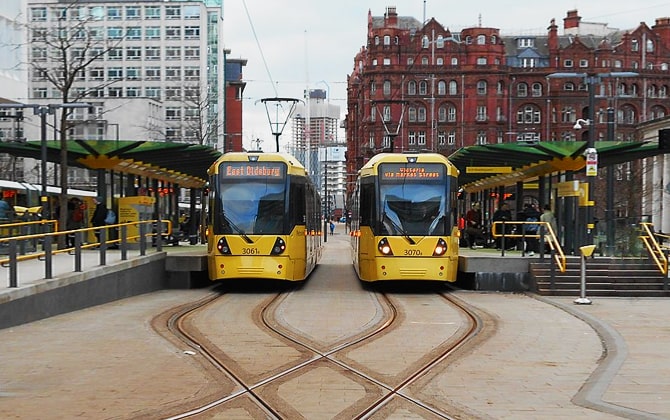Manchester Metrolink is the UK’s largest tram/light rail system, serving Greater Manchester. It spans 103 km (64 miles) with 99 stops across the region. Opened in 1992 as Britain’s first modern street-running tram system, Metrolink now carries approximately 42 million passengers annually (2023/24).
Transport for Greater Manchester (TfGM) owns the system, which is integrated into the region’s Bee Network initiative. The distinctive yellow-and-grey trams connect central Manchester with surrounding towns, the airport, and major destinations, providing frequent service throughout the area.
Manchester Metrolink Map
The Metrolink network features eight lines radiating from Manchester’s city center to all corners of Greater Manchester. The system reaches Altrincham in the southwest, Bury in the north, Rochdale in the northeast, Ashton-under-Lyne in the east, East Didsbury in the south, Eccles/MediaCityUK and the Trafford Centre in the west, and Manchester Airport in the south.
The official 2026 Manchester Metrolink map is color-coded by line and indicates fare zones (Zone 1 in the center through Zone 4 at the outskirts). Key city center hubs like St Peter’s Square, Deansgate-Castlefield, Piccadilly Gardens, and Victoria serve as interchange points where multiple lines intersect.
Manchester Metro map showing different lines and stations. Click on the map to enlarge it or download the Manchester Metrolink map in PDF format.
Manchester Metrolink Lines and Stations
Metrolink’s network consists of the following lines, all converging through Manchester’s city center:
- Altrincham Line – Connects Altrincham through Sale and Cornbrook into Manchester city center (Zone 1). Trams typically continue toward Bury or Etihad Campus.
- Bury Line – Links Bury to the city center via Victoria station, continuing to Altrincham or Piccadilly. Utilizes former heavy rail tracks for part of its route.
- Ashton-under-Lyne Line – Runs east from Manchester to Ashton-under-Lyne, serving key locations like Etihad Campus (Manchester City’s stadium).
- East Didsbury Line – Travels south through Chorlton and Didsbury to East Didsbury, offering connections to bus routes toward Stockport.
- Eccles Line – Goes west to Eccles with a branch to MediaCityUK (Salford Quays). Runs on street in the city and on dedicated track in Salford.
- Trafford Park Line – Opened in 2020, this line serves Old Trafford, Imperial War Museum, and terminates at the Trafford Centre shopping complex.
- Rochdale via Oldham Line – Extends northeast from Manchester Victoria to Rochdale Town Centre, passing through Oldham. Uses a repurposed rail corridor.
- Airport Line – Connects the city center to Manchester Airport via south Manchester and Wythenshawe. A future extension to Terminal 2 is planned.
Every tram stop features shelters, ticket machines, real-time departure displays, and CCTV. Major interchange stations offer connections to national rail or bus services. All 99 stops have step-free access, making the system fully accessible. The fleet consists of 147 modern M5000 trams, operating as single or double units depending on demand.
Manchester Metrolink Schedule & Timetable
Operating Hours Today
Metrolink operates from early morning until late night, seven days a week. Monday to Thursday, trams run from about 6:00 AM until approximately midnight. Friday and Saturday services extend later, running from 6:00 AM until roughly 1:00 AM the following morning. Sundays have slightly reduced hours, typically 7:00 AM to 10:30 PM.
Special event days often feature extended Manchester Metrolink hours or additional services.
Opening and Closing Times
Typical first and last tram times by day of week:
- Monday-Thursday: First trams around 6:00 AM. Last trams leave the city center around 11:15-11:30 PM, with services finishing by midnight.
- Friday-Saturday: First trams around 6:00 AM. Last trams depart central Manchester around 12:15-12:30 AM, with final arrivals by about 1:00 AM.
- Sunday: First trams around 7:00 AM. Last departures around 10:00-10:30 PM, ending by approximately 11:00 PM.
The Airport line has unique early services starting around 3:00 AM from the city to Manchester Airport. The first tram reaches the Airport before 4:00 AM daily, with early services running every 20 minutes until the normal Manchester Metrolink schedule begins at 6:00 AM.
Frequency & Train Schedule
Metrolink runs a “turn-up-and-go” service with trams on all lines approximately every 12 minutes throughout most of the day, seven days a week. In central Manchester, where multiple lines overlap, trams arrive even more frequently—every 3-6 minutes during peak periods.
During weekday rush hours, Metrolink increases capacity by using double trams rather than increasing frequency. Since late 2023, busy sections like city center to Etihad Campus have a tram every 6 minutes from 7:00 AM until end of service on weekdays.
Evening services generally maintain the 12-minute frequency, with late-night trams on Fridays and Saturdays running past midnight (every 12-20 minutes depending on the line).
Journey times are reasonable: Manchester to Manchester Airport takes about 55 minutes, while shorter trips like Manchester to Bury or East Didsbury typically take around 30 minutes.
The high-frequency service means passengers rarely wait long for a tram. With service every 12 minutes on each line (and every 6 minutes in central areas), travel requires minimal planning—just head to a stop and a tram will arrive shortly.
Manchester Metrolink Ticket Prices & Fares
Manchester Metrolink uses a zone-based fare system with four zones (1-4). Here’s a comprehensive breakdown of ticket options and pricing in 2026. All Manchester Metrolink prices are shown in British Pounds (GBP) with approximate US Dollar (USD) equivalents.
Fare Calculator
Metrolink Metro fares are determined by how many zones you travel through. Zone 1 covers Manchester city center, with zones 2-4 extending outward. Single-zone journeys cost less than trips crossing multiple zones.
You can calculate fares using:
- The official Bee Network/TfGM online fare calculator
- Ticket vending machines at tram stops
- Contactless payment (automatic fare calculation)
For example, Manchester Airport is in Zone 4, while city center stops are in Zone 1. A trip between them crosses all four zones and costs more than traveling between two stops in the same zone.
Ticket Types and Day Pass
Manchester Metrolink offers various ticket options to suit different travel needs:
- Single Journey Tickets: Valid for one continuous one-way trip between specified stops. Cost depends on zones traveled.
- Return Tickets: Available as Peak or Off-Peak options. Off-Peak returns are cheaper but valid only after 9:30 AM on weekdays and all day on weekends.
- Day Travelcards: Allow unlimited travel for a whole day. Available as Anytime (valid all day) or Off-Peak (valid after 9:30 AM weekdays, all day weekends). Options include Weekend travelcards and Family travelcards.
- Season Tickets: Available as 7-Day, 28-Day, and Annual passes. Offer significant savings for regular travelers.
- Tap-and-Go Contactless: Use a contactless bank card or phone to tap in and out. Daily charges are capped at £9.50 (≈$11.90) for all zones, or £7.80 (≈$9.75) for off-peak travel.
- Concession Tickets: Children under 5 travel free. Children 5-15 pay approximately half the adult fare. Young people 16-18 can access special discounted or free passes. Seniors and disabled persons can travel free after 9:30 AM weekdays and all day weekends with a valid concessionary pass.
All tickets (except contactless) must be purchased before boarding the tram.
How Much Does Manchester Metro Cost?
Single Journey Fares (Adult):
- 1 zone: £1.40 (≈$1.75)
- 2 zones: £2.80 (≈$3.50)
- 3 zones: ~£4.00 (≈$5.00)
- 4 zones: £4.60 (≈$5.75)
Day Travelcard (Unlimited Day Pass, Adult):
- Zone 1 only: £2.70 (≈$3.40); Off-Peak: £1.90 (≈$2.40)
- Zones 1+2: £4.30 (≈$5.50); Off-Peak: £3.50 (≈$4.40)
- Zones 1-3: ~£6-7 (≈$7.50-8.75); Off-Peak: ~£5-6 (≈$6.25-7.50)
- All zones (1-4): £7.10 (≈$8.90); Off-Peak: £4.90 (≈$6.15)
Child fares are roughly half the adult price. For example, a child single for 1 zone costs £0.70 (≈$0.88), while a 4-zone single is £2.30 (≈$2.88).
Weekly caps apply if using contactless consistently. The all-zones weekly cap is £41 (≈$51.25). Combined bus+tram weekly options are also available (e.g., unlimited bus plus one tram zone for £24.80/week or ≈$31/week).
Fare evasion penalties can reach £100 (≈$125), so always ensure you have a valid ticket or have tapped in correctly.
Routes and Connections
Connections with Manchester Bus and Airport
Metrolink integrates well with other transportation modes. Key connection points include:
- Major Interchanges: Altrincham, Bury, Ashton-under-Lyne, Eccles, and Rochdale Railway Station all feature combined tram, bus, and sometimes rail connections.
- City Centre: Stops like Piccadilly Gardens and Shudehill are adjacent to central bus stops. Victoria and Piccadilly Station connect to national and regional train services.
The Bee Network initiative coordinates buses and trams with unified ticketing. Local buses have a £2 (≈$2.50) flat fare cap, and combination tickets are available, such as the all-day unlimited bus+tram ticket for £9.50 (≈$11.90).
Manchester Airport Connection: Metrolink provides direct service to Manchester Airport, terminating near Terminal 2. The stop connects to all terminals via covered walkways (5-15 minutes walk to check-in areas). The Airport line runs every 12 minutes throughout most of the day, with early morning services starting around 3:40 AM.
At £4.60 (≈$5.75) for a single journey from the city center, the tram offers a cost-effective alternative to trains or taxis. All trams have luggage areas, and the airport stop has elevator access.
Manchester Public Transport Overview
Manchester’s public transport network consists of:
- Buses: An extensive network reaching areas not served by trams or trains. Under the Bee Network integration, buses feature simplified fares (£2 singles, £5 day ticket) that complement the tram system. The £9.50 daily cap for unlimited bus+tram travel encourages multimodal journeys.
- Rail Services: Manchester’s railway stations (Piccadilly, Victoria, Oxford Road) offer local and long-distance connections. Metrolink connects directly to Piccadilly and Victoria stations, allowing smooth transfers between rail and tram.
- Coordinated Planning: The Bee Network implements Manchester’s 2040 Transport Strategy with unified travel information, integrated ticketing, and contactless “tap-and-go” payment across buses and trams.
- Park and Ride and Cycling: Over 3,000 free parking spaces are available at tram stops for Metrolink users. Cycling infrastructure includes bike lanes and rental options near many tram stops.
By 2026, Manchester’s public transport system is significantly more integrated than a decade ago. Metrolink serves as the rapid transit backbone, with buses providing local connections and trains handling longer distances—all functioning together as the Bee Network to enable car-free travel throughout Greater Manchester.
Facilities & Services
Manchester Metro offers various facilities and services to enhance passenger comfort and convenience. Here’s what you need to know about parking and using the Metrolink ticketing system.
Parking Charges per Day
Good news for commuters: parking at Metrolink tram stops is free for tram customers. There is no daily parking charge—you only pay for your tram fare. This policy encourages people to park on the outskirts and take the tram into the city, reducing congestion.
Key points about Metrolink parking:
- Park & Ride facilities are available at over 20 stops, including Bury, Whitefield, Radcliffe, East Didsbury, Ashton Moss, Ashton West, Sale Water Park, Hollinwood, Ladywell, Shaw and Crompton, Navigation Road, and others. Many locations offer several hundred spaces.
- Parking is intended for Metrolink users. While enforcement is generally light, security patrols and CCTV are present.
- Car parks typically operate during tram service hours. Overnight parking on weekdays is generally not permitted.
- On Friday and Saturday nights, overnight parking is allowed at certain Park & Ride sites (including Brooklands, Stretford, Bury, and East Didsbury) as part of a trial. Vehicles must be retrieved by 12 noon the next day.
- All parking areas are well-lit and covered by CCTV, though normal precautions apply regarding valuables.
- Using Park & Ride can offer significant savings compared to city center parking fees.
No special permit is required to use the Park & Ride facilities—simply park your car and board the tram. The system offers a convenient way to integrate car travel with public transport for the first/last mile of your journey.
Manchester Metrolink Card – How to Use
There are several ways to pay for travel on Metrolink:
- Contactless bank cards / phones (tap-and-go): The simplest method for adults. Tap your contactless credit/debit card or smartphone with Apple Pay/Google Pay on the yellow card reader before boarding, and tap again when exiting at your destination. The system automatically charges the correct fare, with daily and weekly caps. Be sure to use the same card/device for all taps to benefit from fare capping. Each traveler must use their own card.
- Bee Network smart card: This reusable smart card (formerly “get me there” card) can be loaded with tram tickets or travelcards online or at ticket machines. Tap it on the yellow reader at the start and end of your journey. The Bee Card can also hold integrated bus/tram tickets.
- Mobile App ticket: Purchase digital Metrolink tickets through the TfGM travel app. Activate your ticket before boarding to display a QR code or confirmation.
How to use contactless or smart card (step-by-step):
- At the tram stop, locate the yellow card reader (usually near the entrance or on the platform).
- Press your card or phone flat against the reader. It will beep or display a green light stating “OK” or “Touch in recorded.”
- When you reach your destination, tap out on a yellow reader as you exit. It will show “Journey complete” or similar.
- If transferring between trams, don’t tap out during the transfer—only tap at the very end of your journey.
- For concessionary passes (elderly/disabled), touch the pass on the reader each time you travel to validate your free ride (only valid after 9:30am on weekdays).
Metrolink operates on a proof-of-payment system with no turnstiles. However, roving inspectors regularly check tickets on board. If found without a valid ticket or properly touched-in card, you may face a standard fare penalty of up to £100 (≈$125).
Paper tickets can be purchased from machines at tram stops. Select your destination or zones, choose your ticket type, and pay by card or cash. Carry your printed ticket with you for inspections.
The contactless and smart card system makes riding Metrolink very convenient, speeding up boarding and offering fare flexibility.
Rules & Useful Tips for Riding
Is Manchester Metrolink Safe? Safety Tips
Manchester Metro is generally safe to use. The system is well-lit, monitored, and regularly used by commuters. Here are key safety points and tips:
- CCTV & Staff Presence: All trams and stations have CCTV surveillance. Many stops have emergency call points and help buttons. Passenger Service Representatives patrol the network, and the TravelSafe Partnership (police and community support officers) conducts extra patrols to deter crime.
- Cleanliness & Maintenance: Trams and stations are generally clean and well-maintained, with damage quickly repaired. Use common sense—if traveling at night, consider sitting near the driver’s cab or other passengers.
- Night Travel: When traveling late (especially alone), stick to well-lit areas within CCTV view. Use the emergency intercom if you feel uncomfortable. Night buses operate after trams stop as a backup option.
- Personal Belongings: While petty theft is not common, remain aware of your belongings, particularly during crowded periods after events.
- Antisocial Behavior: If you encounter disruptive individuals, you can move to another part of the tram. Metrolink has reduced incidents through outreach and enforcement campaigns.
- Tram Safety: Stay behind marked lines on platforms when trams approach. Trams are quiet, so be cautious when crossing tracks—always look both ways.
- COVID-19 and Health: Trams are ventilated and were regularly cleaned during the pandemic. By 2026, ridership has returned to normal levels.
By following these guidelines, you’ll find Metrolink to be a reliable and safe way to travel. Thousands use it daily without incident.
Guide for First-Time Users
If you’re new to Metrolink, here’s a quick guide to make your journey smooth:
Before you board:
Plan your route using the Metrolink map or TfGM journey planner. Key interchange stops include Cornbrook, St Peter’s Square, and Victoria.
Purchase your ticket at the machine or ensure your contactless card/phone is ready to tap. For tourists, a Day Travelcard for all zones provides convenient all-day access.
Find the right platform—check signs and electronic screens for direction and destination information.
Boarding the tram:
Allow passengers to exit before boarding.
Seating is unassigned—take any open seat or stand if crowded.
Use multi-purpose areas for luggage or prams (usually in the center section).
Priority seating is available for those who need it (elderly, pregnant, mobility issues).
Keep items clear of aisles.
While riding:
Listen for stop announcements and watch the digital display.
Trams do not have toilets or refreshment services.
Non-alcoholic drinks and snacks are generally permitted (use common sense). Alcohol is prohibited.
Keep your ticket accessible for inspection.
Transfers: Exit at the interchange stop and walk to the platform for your next line. No re-ticketing is needed as long as your ticket covers that zone.
Exiting:
Move toward the door as your stop approaches.
Press the illuminated button to open doors at quieter stops.
Step carefully off the tram, minding the gap.
Remember to tap out if using contactless or a smart card.
Use the help point button if you need assistance.
Etiquette and rules:
No smoking or vaping on trams or at stations.
Keep noise to a minimum.
Standard bicycles are not permitted (folding bikes are allowed).
Supervise children, especially on platforms and when boarding.
For lost items, contact Metrolink customer service.
After a couple of journeys, you’ll feel perfectly at home on the network. Manchester’s friendly locals and staff are always ready to help if needed.
Interesting Facts & History
Manchester subway has a fascinating history and several noteworthy features:
- First Modern Tram in the UK: Opened in April 1992, Metrolink was Britain’s first modern street-running tram system (except Blackpool’s heritage tramway). It became the model for other UK cities.
- Origins in Rail Conversion: The initial lines repurposed former British Rail commuter routes to Bury and Altrincham, connecting them via city center streets—an innovative approach to urban transit.
- Phased Expansion:
- Phase 1 (1992): Bury to Altrincham via Manchester city center
- Phase 2 (2000): Extension to Salford Quays and Eccles
- Phase 3a (2010-2013): Added lines to Oldham/Rochdale, Chorlton, and Droylsden
- Phase 3b (2013-2014): Extended to Ashton-under-Lyne, East Didsbury, and Manchester Airport
- Second City Crossing (2017): Added capacity through downtown
- Trafford Park Line (2020): Extended service to the Trafford Centre
- Network Stats: With 99 stops and 103 km (64 miles) of route, Metrolink is the UK’s largest light rail network. Annual ridership reached 42 million in 2023/24.
- Tram Fleet: The original T-68 trams were replaced by 2014 with 147 Bombardier M5000 trams. Unlike many European systems, Metrolink uses high-floor platforms (0.9m) to maintain compatibility with converted rail stations.
- Safety Record: Metrolink has maintained a good safety record with no major fatal accidents on board trams in its history.
- Cultural Icon: The trams have become part of Manchester’s identity, appearing in media and events including the 2002 Commonwealth Games. Some trams are named after notable local figures like Tony Wilson and Sir Alex Ferguson.
- Operational Features: The system reaches speeds up to 50 mph on former rail sections but slows to 10-20 mph on city streets. It uses 750V DC overhead lines and operates with a barrier-free automated ticketing system.
- Interesting Quirks: The Airport line has a rare single-track section near Roundthorn. Some stops like Victoria occupy sites of 19th-century railway stations. In 2018, a tram-train trial tested future technology allowing trams to run on national rail tracks.
From its humble beginnings with two lines, Metrolink has become an essential part of Greater Manchester’s identity and transportation network.
Future Expansions & Upcoming Lines
Manchester has ambitious plans to expand the Metrolink network further. Here are the key developments on the horizon:
- Trafford Centre to Stockport Extension: The most likely next major project will connect East Didsbury to Stockport town center. This would finally bring tram service to Stockport, a significant town currently without Metrolink access. Feasibility studies and business cases were being developed as of late 2024, with construction potentially beginning in the coming years.
- Tram-Train Projects: Greater Manchester is exploring tram-train technology that would allow Metrolink services to run on existing heavy rail lines. Proposals include routes to Bolton and Wigan, plus an Oldham to Heywood via Rochdale service. At least one pathfinder project (likely Oldham-Rochdale-Heywood) is planned to test this concept.
- Middleton Spur: A short extension from the Bury line to serve Middleton town is proposed. Though relatively small in distance, this would provide valuable service to a community currently without tram access.
- Airport Line Enhancements: Two developments are planned:
- Extension from the current airport station to Terminal 2, directly serving the expanding terminal
- Creation of a Wythenshawe Loop, potentially connecting to the future HS2 station
- Ashton to Stalybridge: An eastward extension from Ashton-under-Lyne to Stalybridge would connect with TransPennine rail routes and extend service into eastern Tameside.
- New Infill Stops: Plans include stations at Elton Reservoir (between Bury and Radcliffe) and Sandhills (between MediaCityUK and Broadway) to serve new housing developments.
- Long-term Vision (beyond 2026): The 2040 plan envisions potential tram or tram-train services to areas like Wilmslow, Macclesfield, Heywood, and Warrington, plus possible conversion of more suburban rail lines to tram operation.
- Integration with HS2 and Northern Powerhouse Rail: Metrolink will adapt to connect with future high-speed rail stations at Manchester Piccadilly and Airport, helping distribute passengers throughout the metro area.
The main challenge for these expansions is funding. As of 2026, local leaders were seeking government funding or alternative financing options. If funding is secured in the near future, the Stockport extension could potentially open by the late 2020s, with tram-train services beginning in a similar timeframe.
